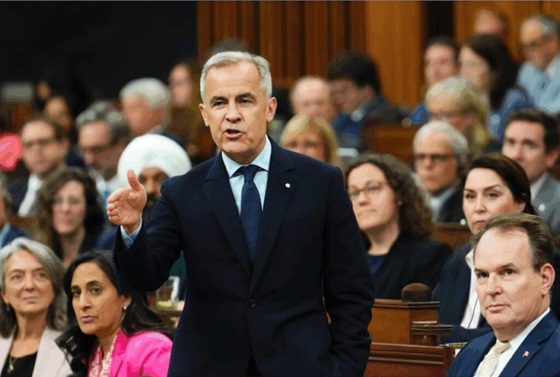Economy
Canada’s federal government disregards its own fiscal rules—unlike Sweden

From the Fraser Institute
By Grady Munro and Jake Fuss
During the 1970s and 1980s, Canada and Sweden both saw a deterioration in government finances. However, hard times in the early 1990s transformed the approach to fiscal policy by governments in both countries, including reducing spending and borrowing, and ultimately returning to balanced budgets. While Swedes have carried on the legacy of fiscal responsibility in subsequent decades, Canadians seem to have forgotten the hard lessons of recent history and have fallen back on the fiscal approach that got us into trouble in the first place.
In his recent book, Swedish economist Johan Norberg explains that for most of its modern history Sweden has been a testament to the success of the free market, rather than a model socialist economy. The country only experimented with socialism for a short period, with disastrous results.
Sweden’s socialist experiment during the 1970s and 1980s saw substantial income redistribution and the introduction of a large welfare state. As a result, the size of government doubled as a share of the economy (measured by GDP). Yet despite increases in taxes, particularly targeting corporations and the wealthy, the government could not raise the funds to pay for such a sizable expansion of the welfare state. Instead, Sweden ran deficits in every year from 1970 to 1987, government debt rose from less than 18 per cent of the economy (GDP) in 1970 to over 70 per cent in 1985, and the private sector completely stagnated.
This approach brought about a financial crisis in the early 1990s that saw interest rates briefly rise as high as 500 per cent. In the wake of this crisis, the Swedish government declared the socialist experiment a failure, and the country saw substantial reform that emphasized balanced budgets, lower taxes, and an open business environment. Rules were set in place to ensure fiscal discipline, and as a result the country has enjoyed consistent surpluses and government debt has fallen from 83.2 per cent of the economy in 1998 to 58.8 per cent in 2021, despite still maintaining a large welfare state.
During the 1970s and 1980s, Canada also experienced a deterioration in government finances. Canada’s issues stemmed from a substantial expansion in the size and role of government in conjunction with rising interest rates. The federal government ran uninterrupted budget deficits from 1970 through to the mid-1990s. Federal government debt rose to over 70 per cent of GDP during this period and debt interest costs were consuming more than one-third of federal government revenues.
By the early 1990s federal finances were in shambles and the economy was stagnant. A new federal government was elected, led by Jean Chrétien, which implemented significant fiscal reform in 1995 based on spending restraint, balanced budgets and lower taxes. The provinces enacted similar reforms, and from the late 1990s through the 2000s, Canadians enjoyed consistent surpluses, debt reduction, and strong economic growth.
While there are clear parallels between the countries, unlike Sweden, Canadians has since reverted back to the risky fiscal approach of the 1970s and 1980s. Since 2015, Canada has seen historically high federal spending, and a string of federal and provincial budget deficits. Consequently, government debt and its associated costs have grown substantially.
Since the 1990s, both Canada and Sweden have had fiscal rules in place to help ensure the health of government finances. But while the Swedish government has largely stuck to its surplus goal by being disciplined with finances, Canada’s current federal government has consistently disregarded its own commitments. Indeed, it has violated its own fiscal anchors several times since 2015, and rather than adopt the discipline necessary to get back on track, the government simply moves the goalposts.
Simply put, Swedes have learned their lesson from their experience in the 1970s to 1990s, whereas Canadians appear to have forgotten. This raises the question—do Swedes have better memories?
Authors:
Business
Canada Hits the Brakes on Population

The population drops for the first time in years, exposing an economy built on temporary residents, tuition cash, and government debt rather than real productivity
Canadians have been told for years that population decline was unthinkable, that it was an economic death spiral, that only mass immigration could save us. That was the line. Now the numbers are in, and suddenly the people who said that are very quiet.
Statistics Canada reports that between July 1 and October 1, 2025, Canada’s population fell by 76,068 people, a decline of 0.2 percent, bringing the total population to 41,575,585. This is not a rounding error. It is not a model projection. It is an official quarterly population loss, outside the COVID period, confirmed by the federal government’s own data
The reason matters. This did not happen because Canadians suddenly stopped having children or because of a natural disaster. It happened because the number of non‑permanent residents dropped by 176,479 people in a single quarter, the largest quarterly decline since comparable records began in 1971. Permit expirations outpaced new permits by more than two to one. Outflows totaled 339,505, while inflows were just 163,026
That is the so‑called growth engine shutting down.
Permanent immigration continued at roughly the same pace as before. Canada admitted 102,867 permanent immigrants in the quarter, consistent with recent levels. Births minus deaths added another 17,600 people. None of that was enough to offset the collapse in temporary residency. Net international migration overall was negative, at minus 93,668
And here’s the part you’re not supposed to say out loud. For the Liberal‑NDP government, this is bad news. Their entire economic story has rested on population‑driven GDP growth, not productivity. Add more people, claim the economy is growing, borrow more money, and run the national credit card a little harder. When population growth reverses, that illusion collapses. GDP per capita does not magically improve. Housing shortages do not disappear. The math just stops working.
The regional numbers make that clear. Ontario’s population fell by 0.4 percent in the quarter. British Columbia fell by 0.3 percent. Every province and territory lost population except Alberta and Nunavut, and even Alberta’s growth was just 0.2 percent, its weakest since the border‑closure period of 2021
Now watch who starts complaining first. Universities are already bracing for it. Study permit holders alone fell by 73,682 people in three months, with Ontario losing 47,511 and British Columbia losing 14,291. These are the provinces with the largest university systems and the highest dependence on international tuition revenue
You’re going to hear administrators and activists say this is a crisis. What they mean is that fewer students are paying international tuition to subsidize bloated campuses and programs that produce no measurable economic value. When the pool of non‑permanent residents shrinks, departments that exist purely because enrollment was artificially inflated start to disappear. That’s not mysterious. That’s arithmetic.
For years, Canadians were told that any slowdown in population growth was dangerous. The truth is more uncomfortable. What’s dangerous is building a national economic model on temporary residents, borrowed money, and headline GDP numbers while productivity stagnates. The latest StatsCan release doesn’t just show a population decline. It shows how fragile the story really was, and how quickly it unravels when the numbers stop being padded.
Subscribe to The Opposition with Dan Knight
Business
White House declares inflation era OVER after shock report

The White House on Thursday declared a decisive turn in the inflation fight, pointing to new data showing core inflation has fallen to its lowest level in nearly five years — a milestone the administration says validates President Donald Trump’s economic reset after inheriting what it calls a historic cost-of-living crisis from the Biden era. In a statement accompanying the report, White House Press Secretary Karoline Leavitt said inflation “came in far lower than market expectations,” drawing a sharp contrast with the 9 percent peak under President Joe Biden and arguing the numbers reflect sustained relief for American households. “Core inflation is at a new multi-year low, as prices for groceries, medicine, gas, airfare, car rentals, and hotels keep falling,” Leavitt said, adding that lower prices and rising paychecks are expected to continue into the new year.
According to the White House, core inflation — widely viewed by economists as the most reliable gauge because it strips out volatile food and energy costs — is now down roughly 70 percent from its Biden-era high. Officials noted that if inflation continues at the pace of the last two months, it would be running at an annualized rate of about 1.2 percent, well below the Federal Reserve’s 2 percent target. The report also highlighted broad-based price moderation across consumer staples and services, with declines in groceries, dairy, fruits and vegetables, prescription drugs, clothing, airfares, natural gas, car and truck rentals, and hotel prices. Average gas prices have fallen to multi-year lows, while rent inflation has dropped to its lowest level since October 2021, a shift the administration attributes in part to tougher enforcement against illegal immigration and reduced pressure on housing demand.
Wages, the White House says, are rising alongside easing prices. Private-sector workers are on track to see real wages increase by about $1,300 in President Trump’s first full year back in office, clawing back purchasing power lost during the inflation surge of the previous administration. Gains are strongest among blue-collar workers, with annualized real earnings up roughly $1,800 for construction workers and $1,600 for manufacturing employees. Administration officials also took aim at critics who warned Trump’s tariff policies would reignite inflation, arguing the data shows no demonstrable inflationary impact despite repeated predictions from Wall Street and academic economists.
NEC Director Kevin Hassett on the latest inflation report: "It was just an absolute blockbuster report… We looked at 61 forecasts, and this number came in better than every single one of them." 🔥 pic.twitter.com/rBJpkmjuNa
— Rapid Response 47 (@RapidResponse47) December 18, 2025
Even commentators across the media spectrum acknowledged the strength of the report. CNBC’s Steve Liesman called it “a very good number,” while CNN’s Matt Egan said it was “another step in the right direction.” Harvard economist Ken Rogoff described the reading as “a better number than anyone was expecting,” adding, “There’s no other way to spin it.” Bloomberg’s Chris Anstey noted the figure came in two-tenths below the lowest estimate in a survey of 62 economists, calling it “remarkable,” while The Washington Post’s Andrew Ackerman wrote that inflation “cooled unexpectedly,” easing pressure on household budgets.
For the White House, the message was blunt: the inflation era is over. Officials framed Thursday’s report as proof that Trump has followed through on his promise to defeat the cost-of-living crisis he inherited, laying what they called the groundwork for a strong year ahead. As the president told the nation this week, the administration insists the progress is real — and that, in his words, the best is yet to come.
-

 Alberta2 days ago
Alberta2 days agoAlberta’s huge oil sands reserves dwarf U.S. shale
-

 Indigenous2 days ago
Indigenous2 days agoResidential school burials controversy continues to fuel wave of church arsons, new data suggests
-

 Health2 days ago
Health2 days agoSaskatchewan woman approved for euthanasia urged to seek medical help in Canada rather than US
-

 Business1 day ago
Business1 day agoOttawa Pretends To Pivot But Keeps Spending Like Trudeau
-

 International2 days ago
International2 days agoFBI didn’t think it had cause to raid Trump but DOJ did it anyway
-

 Daily Caller2 days ago
Daily Caller2 days agoParis Climate Deal Now Decade-Old Disaster
-

 International1 day ago
International1 day agoBondi Beach Shows Why Self-Defense Is a Vital Right
-

 Energy1 day ago
Energy1 day agoLiberals Twisted Themselves Into Pretzels Over Their Own Pipeline MOU








